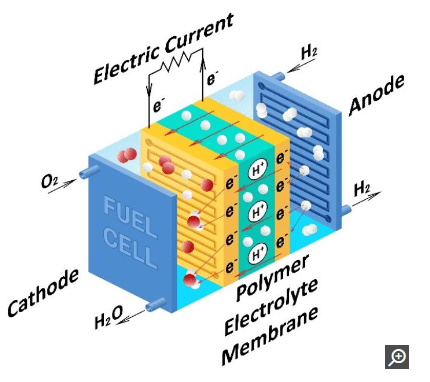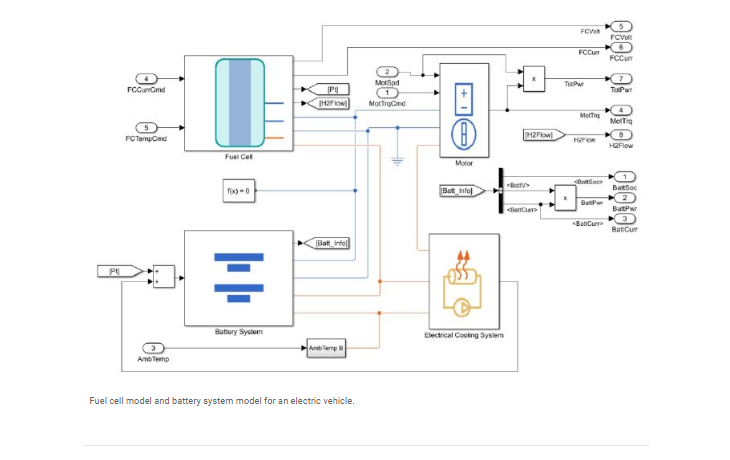Model PEM fuel cells with Simulink and Simscape
An electrochemical system that generates electricity by utilizing reactants is known as a fuel cell. Popular technology is the polymer electrolyte membrane (PEM) fuel cell, which produces electricity and water as byproducts through a chemical reaction between hydrogen and oxygen. A semipermeable membrane in PEM fuel cells prevents electron flow while allowing proton transport. This kind of fuel cell is also known as a proton-exchange membrane fuel cell because of this property. At the anode of the fuel cell, hydrogen splits into protons and electrons, as shown below. The electrons flow through an external circuit, generating an electric current, while the protons travel through the membrane. At the cathode end of the fuel cell, oxygen joins protons and electrons to form heat and water.

Fuel Cell PEM.
When compared to other types of fuel cells, PEM fuel cells are valued due to their low operating temperatures and pressures. The technology is popular for use in electric vehicles as a replacement or addition to battery systems for these reasons. When combined with an electrolyzer and a renewable power source, PEM fuel cells are utilized for the production of electricity at a stationary location and are regarded as a component of a system for the green storage and delivery of energy.
Engineers need models of varying fidelity in order to use simulation to create fuel cell-based applications. Among these scenarios are:
utilizing a fuel cell model that explains the electrochemical reaction to evaluate the temperature and electrical performance of the fuel cell stack.
Utilizing a less comprehensive system-level fuel cell model to enhance the range, performance, and thermal effects of a fuel cell electric vehicle.
utilizing a fuel cell model that is suitable for hardware-in-the-loop testing in the process of developing and improving a fuel cell control system.
utilizing a fuel cell model to design and simulate electrical generation systems with functional details for component and balance-of-plant sizing.
determining the economic viability of fuel cell and electrolyzer models for producing hydrogen and producing power.
Model libraries for simulating fuel cells are available from SimscapeTM and Simscape ElectricalTM. These models can be used by engineers to create control systems for fuel cells and study fuel cells as a source of electricity in an electrical system. These models support the development of fuel cell control systems for electric vehicles that include closed-loop design and control logic when used with Simulink®. Designers can create code from these energy component models for approval and creation with help for AUTOSAR and confirmation work processes to accomplish functionalities like current, voltage, and power observing and warm administration.
The Simscape Electrical fuel cell model offers two levels of fidelity for engineers who want to create a fuel cell stack model. At the nominal temperature and pressure, the Nernst voltage is provided by a simplified fuel cell model. The Nernst voltage is output by a more in-depth fuel cell model using pressure and air flow rate input signals. Engineers can evaluate heat generation and voltage-current characteristics using either model.
Simscape Electrical fuel cell model.
With Simscape, engineers can customize a complete PEM fuel cell model. This includes the fuel cell stack and balance-of-plant components such as air compressors, humidifiers, hydrogen recirculation paths, cooling systems, and water management. This first-principles–based fuel cell model using electrochemistry enables development of a PEM fuel cell at both the component and system levels. This level of fuel cell model detail lets engineers model functionalities like current, voltage, and power monitoring and thermal management.

A fuel cell model as part of an electrical system provides a framework for performing trade studies to economize fuel cell stack efficiency, hydrogen and oxygen utilization, and fuel and air consumption.

Simscape Electrical 6 kW fuel cell model.
A PEM fuel cell model with electrochemical reactions, hydrogen and air handling, and thermal management systems can be used to model a battery system and electric motor for a fuel cell virtual vehicle, as shown in Powertrain BlocksetTM.


















